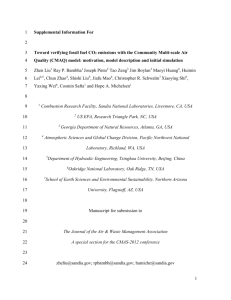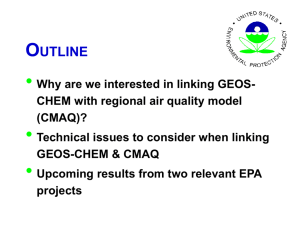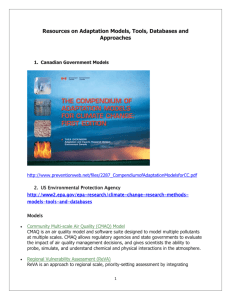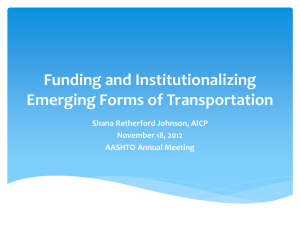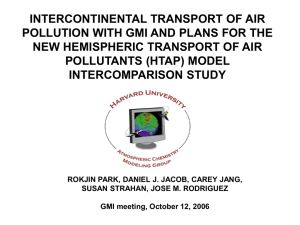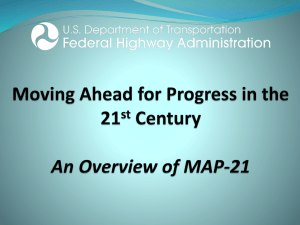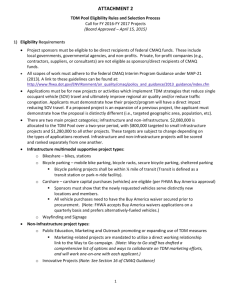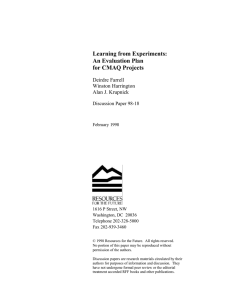ACT FAST Act webinar slides - Association for Commuter
advertisement
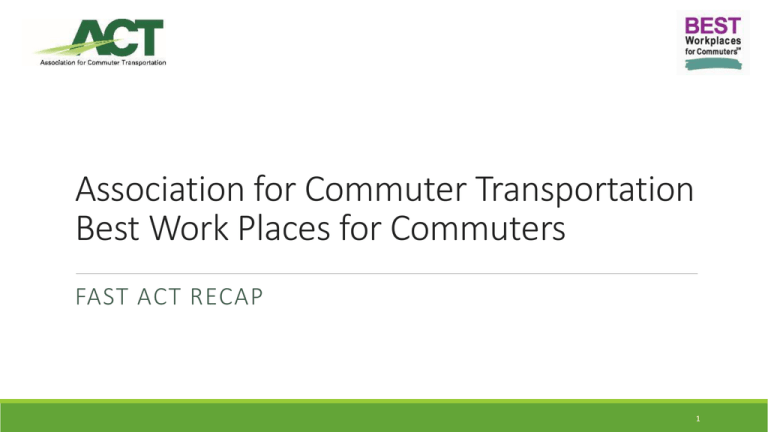
Association for Commuter Transportation Best Work Places for Commuters FAST ACT RECAP 1 FAST Act – The Nuts & Bolts Fixing America’s Surface Transportation (FAST) Act Passed on December 3, 2015 • • • 5-year authorization for federal surface transportation program passenger rail program (FY16-FY20) Incorporates rail program in broader surface bill for first time Adds new highway freight formula and highway freight discretionary grant program FY16 FY17 FY18 FY19 FY20 $305 billion 2 FAST Act – Funding • $305 billion over 5 years • Maintains 80-20 split between highway and transit • Increases funding ~5% from FY 2015-FY 2016 and roughly 2%/year through life of bill $61 21% $225 79% Highways Transit (in billions of dollars) 3 FAST Act – FHWA FY 2015 Obligation Authority % Increase FY 2016 FY 2017 FY 2018 FY 2019 FY 2020 $40.26b $42.36b $43.26b $44.23b $45.26b $46.36b 5.2% 2.1% 2.2% 2.3% 2.4% Highways Federal-Aid Highways Formula National Significant Freight & Highway Projects Discretionary TIFIA Other 4 FAST Act – CMAQ What is CMAQ (Congestion Mitigation Air Quality Program) • CMAQ is a Federal Highway formula program that a wide variety of TDM and employer based commuter activities are eligible for funding. • For States that have non-attainment areas for ozone or particulate matter, CMAQ funding must be used to achieve air quality benefits in those areas that are in non-attainment. • Who controls allocation of CMAQ varies from State-to-State. In some cases, the State controls most, if not all CMAQ funding, in some cases, CMAQ project selection has been delegated to metropolitan planning organization • CMAQ funds may be used to fund both capital and operating projects – with exceptions – For more information on what types of projects may be eligible under CMAQ, contact Pavluchuk@actweb.org To determine how you may apply for CMAQ funds, contact your local Metropolitan Planning Organization 5 FAST Act – CMAQ • Few programmatic changes made to CMAQ • Makes two eligibility changes 1. Clarifies eligibility of port related freight operations (so long as emission reductions are attained) 2. Makes installation of vehicle to infrastructure communication installation eligible FY 2015 FY 2016 FY 2017 FY 2018 FY 2019 FY 2020 Total FY16-20 CMAQ Obligations % Increase $2.27b $2.31b $2.36b $2.40b $2.45b $2.50b 1.8% 2.1% 1.9% 1.8% 2.0% $12.02b • Maintains that carpool/vanpool projects are still eligible for 100% Federal share (all other projects have a maximum of 80% Federal Share) 6 FAST Act – CMAQ Post Authorization CMAQ Issues • Need DOT to create clear and definitive guidance and practices o What one FHWA State office allows under CMAQ, another does not. There is a need for consistency in rulings. • Clarify difference between operations/labor and education/outreach o Operations/Labor are only eligible to receive CMAQ funding for up to 5 years. Education & Outreach have no limitations. Clarity & consistency needs to be made when it comes to whether labor associated with education & outreach is subject to limitation 7 FAST Act – CMAQ Post Authorization CMAQ Issues • Clarify use of CMAQ funds for incentives o Some FHWA state offices allow CMAQ funds to be used for commuter incentives, while others do not. Clarity & consistency needs to be set on the question. • Amend CMAQ guidance related to vanpools o Current guidance refers to leasing of vanpools. Vanpool arrangements between the public and private sector are ‘contract for service’ agreements, not leases. 8 Question & Answers Related to CMAQ To ask a question, please type it into the question box on your screen or use the chat function 9 FAST Act – STBG Program (STBG) Surface Transportation Block Grant Program • STBG replaces the Surface Transportation Program (STP) • There are minimal differences between STBG and STP • STBG has a wide array of eligibilities, including almost all TDM and employer based commuter programs. • STBG funds are controlled jointly by MPOs and State DOTs (more on that in a moment) STBG Obligations FY 2015 FY 2016 FY 2017 FY 2018 FY 2019 FY 2020 Total FY16-20 $10.08b *$11.42b #$11.66b #$11.88b #$12.14b $58.27b * $11.16b * Includes $835 million set-aside for TAP program # Includes $850 million set-aside for TAP-Program 10 FAST Act – STBG Program (STBG) Surface Transportation Block Grant Program – Local Control • Increases rate of STBG apportionment to metropolitan regions by 1% per year until FY20 - total of 55% of program in FY20 % Controlled by MPO • FY 2015 50% FY 2016 51% FY 2017 52% FY 2018 53% FY 2019 54% FY 2020 55% This change amounts an additional $3.4 billion over life of the bill 11 FAST Act – STBG (STBG) Surface Transportation Block Grant Program – TAP Program • • Transportation Alternatives Program (TAP) is folded into the STBG program TAP maintains all programmatic rules and form – folding of TAP into STBG purely a structural and cosmetic change What is TAP? • Federal Funding program controlled by States and MPOs with eligible to be used on active transportation projects/programs including bike-trails, complete streets, safe routes to schools, and rails-to-trails. • Eligibility expanded to include nonprofits with safety programs • 50% of the funds allocated to a state for the TAP set-aside shall be directly sub-allocated to MPOs TAP Set-Aside FY 2015 $819.9 million FY 2016 $835 million FY 2017 $835 million FY 2018 $850 million FY 2019 $850 million FY 2020 $850 million • 50% of the funds shall be made available by the State through a competitive process 12 Question & Answers Related to STBG To ask a question, please type it into the question box on your screen or use the chat function 13 FAST Act – Planning Process Changes to the Planning Process – Commute Less • Requires that State and MPO long-range plans and TIPs include recognition and existence of intercity bus and commuter vanpool providers operating in a State or region regardless of contractual partnerships and that such plan and TIP include steps to develop and integrate these programs. • Requires that MPOs participation plan specifically identifies and includes those who offer employer-based commuting programs (such as carpool, telework, vanpool, shuttle or parking-cash out) as well as private providers of public transportation. 14 FAST Act – Planning Process Changes to the Planning Process – Commute Less • Clarifies that the Congestion Management Process required for areas over 200,000, shall include TDM and employer-based commuting programs (such as carpool, telework, vanpool, shuttle or parking-cash out) as well as private providers of public transportation. • Allows States and MPOs to create a congestion management plan that develops regional goals to reduce VMT during peak commuting hours includes projects and programs to meet such plans. In developing the plan, MPOs shall consult with employers, TMAs, public, non-profit, and private providers of mass transportation. 15 FAST Act – Planning Process Commute Less – Next Steps • ACT will work with USDOT on the development of Best Practices and Capacity Building • Capacity building will include training for: • Employers and TMAs on how to engage in the planning process and what can be expected from doing so • MPOs and State DOTs and identifying TMAs, Employers, and others who can or are providing transportation solutions. • All parties on partnership opportunities and examples of projects an programs 16 FAST Act – Planning Process Commute Less – Next Steps • Work with House and Senate appropriators on setting aside planning and other funds to encourage MPOs to create such plans and provide adequate training and resources • Develop legislation to amend the FAST Act in order to require these actions (either as a part of the planning process or performance measurement – see ahead) 17 FAST Act – Performance Measures Performance Measures • No changes made to Section 150 on performance measurements • DOT is incredibly late releasing final rules on performance measurements o DOT has yet to release Notice of Proposed Rule on: CMAQ System Performance • New Performance Management Data Support Program o USDOT may use up to $10 million/year to increase the level of data that States and MPOs collect Potential for pilot projects 18 Question & Answers Related to Planning & Performance To ask a question, please type it into the question box on your screen or use the chat function 19 FAST Act – HOV-Tolling • Requires that Tolling and HOV facilities provide the same access and terms to an over-the-road (intercity) bus as is provided to publically owned buses. • Maintains language related to restrictions on allowing Non-HOV vehicles (HOT, energy efficient, etc.) requiring the HOV facility to maintain an adequate speed and flow. 20 FAST Act – HOV-Tolling • Strengthens language regarding HOV facilities that fall into a state of degradation. Requires States to submit a plan on how to bring an HOV facility to standard. The State has 180 days to provide that report and USDOT must approve such plan. o Gives USDOT the authority to waive this section if its in the best interest of the travelling public. • Restricts the ability of States to ‘hold’ slots in the Interstate Tolling program. 21 FAST Act – Innovation Innovation – University Transportation Centers UTC Program remains under the OST-R Highway Research & Development, Technology and Innovation Deployment Program, and Training & Education program will be administered by FHWA Authorization Levels: $72,500,000 for fiscal year 2016 $75,000,000 for fiscal year 2017 $75,000,000 for fiscal year 2018 $77,500,000 for fiscal year 2019 $77,500,000 for fiscal year 2020 No changes made to the establishment and operation of the UTC program or ‘Role of Centers’ 22 FAST Act – Innovation Innovation – Advanced Transportation & Congestion Management Technologies Deployment • Discretionary program where USDOT will annually make grants to model deployment sites for large scale installation & operation of advanced technologies to address transportation problems. • Eligible entities include public sector bodies (State/local body, transit agency, MPO, or a consortium of UTCs) • 5 to 10 grants shall be made per year • Funding for a program of projects, not individual applications • Must partner with private sector • Eligible activities include a wide variety of ITS and TDM projects Authorization Levels: $60,000,000 per year 23 FAST Act – Innovation Innovation – Smart Cities Study Study to be conducted by USDOT on digital technologies including shared mobility, data, TNCs, and ondemand transportation services. The study shall look to: • Understand the degree to which cities are adopting these technologies • Assess future planning, infrastructure, and investment needs; and • To provide best practices to plan for Smart Cities 24 Question & Answers Related to Tolling/HOV and Innovation To ask a question, please type it into the question box on your screen or use the chat function 25 FAST Act – Transit Transit Transit Formula Transit Capital Improvement Grants Positive Train Control Discretionary Other 26 FAST Act – Transit Transit Formula Grants • • $9.3b in FY16 rising to $10.2b in FY20 Removes requirement for areas over 200k people to spend a minimum of 1% on transit enhancements Capital Investment Grants • • • • • • • New Starts, Small Starts, Core Capacity $2.3b per year for FY16-20 through general appropriations Decreases federal match from 80% to 60% for New Starts Increases maximum Small Starts grant and projects costs from $75m to $100m And $250m to $300m, respectively Opens eligibility to include joint public transportation and intercity passenger rail projects Capital investment grant projects with P3 elements will be streamlined by USDOT 27 FAST Act – Transit Bus and Bus Facilities • • • $428m FY16 rising to $465m in FY20 for formula Reestablishes discretionary grant program with $268m in FY16 rising to $344m in FY20 $55m per year within the discretionary funds will be reserved for low and no emission bus program Other • • • • Fixed Guideway SGR funded at $2.5b in FY16 rising to $2.68b in FY21 High Density State Apportionment flat line funding FY16-20 TOD pilot program funded at $10m per year Buy-America increases from 60% domestic content of rolling stock in FY16 up to 65% in FY18 and up to 70% in FY20 28 Question & Answers Related to Transit To ask a question, please type it into the question box on your screen or use the chat function 29 FAST Act – Freight National Highway Freight formula program • Formula program with $1.15b in FY16 rising to $1.5b in FY20 • State apportionments are based on current highway formulas, not the amount or value for tonnage of freight moving through a state • Pre-determines which projects are best for local and state leaders by requiring a minimum of 90% of a state’s funding go to highways Nationally Significant Freight and Highway Projects: • • • • • Discretionary program with $800m in FY16 rising to $1b in FY20 Projects over $100m and 30% of state apportionment 60% federal match and grant awards must exceed $25m Caps funding for multimodal projects at $500m (11% of program) for entire 5 years Opens back-door to reintroduce earmarks 30 Final Questions & Answers Resources: Jason Pavluchuk Association for Commuter Transportation Pavluchuk@Actweb.org 31
